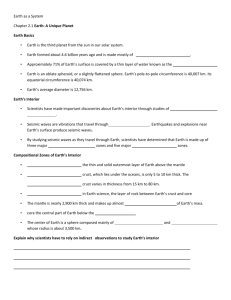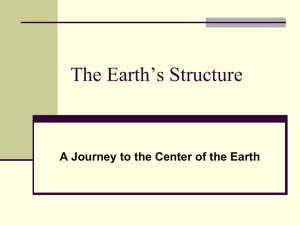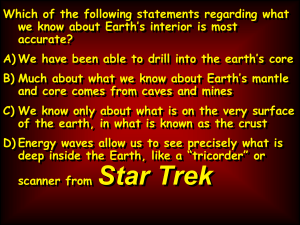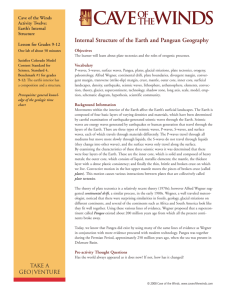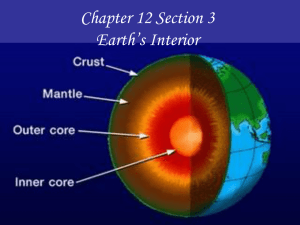Earth`s Interior
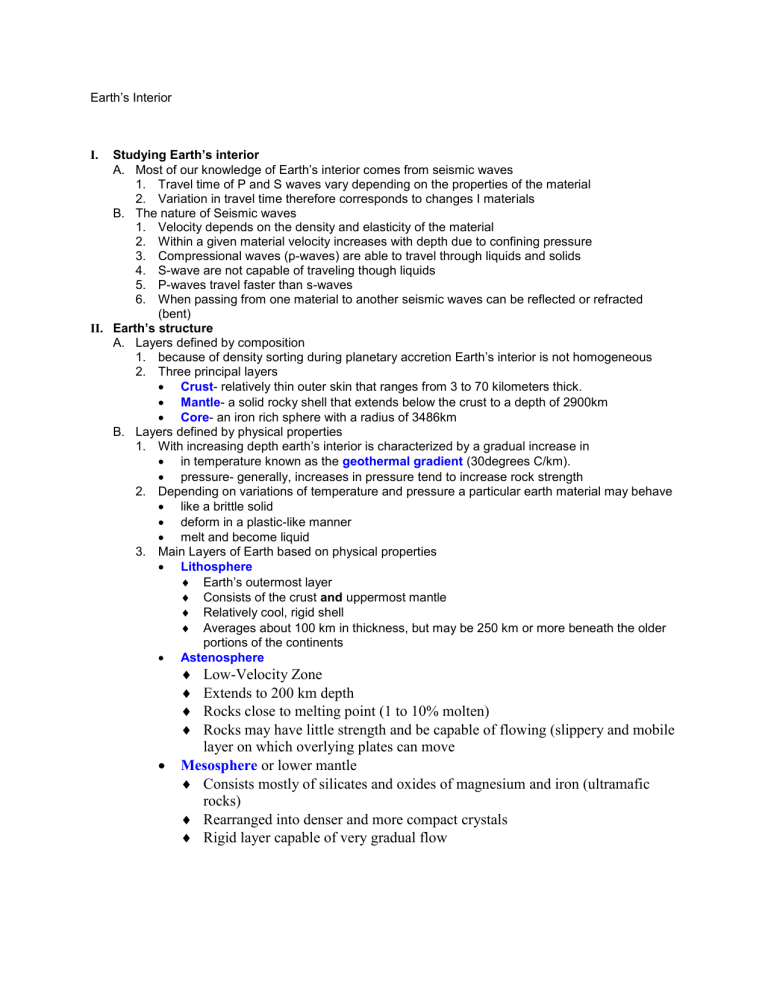
Earth’s Interior
I.
Studying Earth’s interior
A. Most of our knowledge of Earth’s interior comes from seismic waves
1. Travel time of P and S waves vary depending on the properties of the material
2. Variation in travel time therefore corresponds to changes I materials
B. The nature of Seismic waves
1. Velocity depends on the density and elasticity of the material
2. Within a given material velocity increases with depth due to confining pressure
3. Compressional waves (p-waves) are able to travel through liquids and solids
4. S-wave are not capable of traveling though liquids
5. P-waves travel faster than s-waves
6. When passing from one material to another seismic waves can be reflected or refracted
(bent)
II.
Earth’s structure
A. Layers defined by composition
1. because of density sorting during planetary accretion Earth’s interior is not homogeneous
2. Three principal layers
Crust - relatively thin outer skin that ranges from 3 to 70 kilometers thick.
Mantle - a solid rocky shell that extends below the crust to a depth of 2900km
Core - an iron rich sphere with a radius of 3486km
B. Layers defined by physical properties
1. With increasing depth earth’s interior is characterized by a gradual increase in
in temperature known as the geothermal gradient (30degrees C/km).
pressure- generally, increases in pressure tend to increase rock strength
2. Depending on variations of temperature and pressure a particular earth material may behave
like a brittle solid
deform in a plastic-like manner
melt and become liquid
3. Main Layers of Earth based on physical properties
Lithosphere
Earth’s outermost layer
Consists of the crust and uppermost mantle
Relatively cool, rigid shell
Averages about 100 km in thickness, but may be 250 km or more beneath the older portions of the continents
Astenosphere
Low-Velocity Zone
Extends to 200 km depth
Rocks close to melting point (1 to 10% molten)
Rocks may have little strength and be capable of flowing (slippery and mobile layer on which overlying plates can move
Mesosphere or lower mantle
Consists mostly of silicates and oxides of magnesium and iron (ultramafic rocks)
Rearranged into denser and more compact crystals
Rigid layer capable of very gradual flow
Outer Core
Composed mostly of Iron Nickel alloy
liquid layer
convection within the outer core generates the Earth’s magnetic field.
Inner Core
Sphere with a radius of 3486km
material is behave like a solid
III.
Discovering Earth’s major boundaries
A.
The Moho (Mohovoricic Discontinuity)
1.
Separates crustal material from the upper mantle
2.
Identified by change in the velocity of p-waves
B.
The Core-Mantle Boundary
1.
Based on the observation that pwaves disappear between 105 and
140 degrees of the epicenter of an earthquake- this is commonly referred to as the P-wave Shadow Zone
2.
Characterized by refraction of P-waves as they enter the liquid outer core
3.
The fact that S-waves disappear (and never reappear) at 105 degrees provides the evidence of a liquid outer core
IV.
Crust
A.
Continental Crust
1.
Thickness ranges from 29 km to 65 km (18 mi. to 40 miles)
2.
Average composition is granitic.
B.
Ocean Crust
1.
Thickness ranges from 4.8 km to 8.0 km (3 mi to 5 mi.)
Average composition is basaltic
V.
Mantle
A.
Contains 82% of Earth’s volume
B.
Solid, rocky layer
C.
Upper portion has the composition of the ultramafic rock peridotite
D.
Two parts
1.
Mesosphere (lower mantle)
2.
Asthenosphere or upper mantle
VI.
Core
A.
Larger than the planet Mars
B.
Two parts
1.
outer core-liquid outer layer
2.
inner-core solid inner layer
C.
Density
1.
Average density is nearly 11g/cm
3



